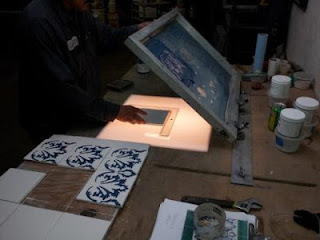Los Angeles is a place where California history is still held sacred. Amongst the downtown skyscrapers and recently built Civic Center facilities, such as the Walt Disney Concert Hall designed by architect Frank Gehry, you’ll find everything from Olvera Street (the birthplace of the city of Los Angeles, which started as Pueblo de La Reina De Los Angeles in 1781), to Union Station (built in 1939 in a modern, Art Deco, Mission/Spanish Revival architectural style), and everything in between.
 |
| Arto Alajian's signature on brick is proudly displayed at the ARTO's Brick and California Paver factory in Gardena, CA. |
With history on their minds, I, as well as several architects and design professionals, recently toured the ARTO Brick and California Pavers factory complex in Gardena, CA. Along with the tour, an American Institute of Architects (AIA) Continuing Education Course, “The Beautiful Face of Concrete: Using Precast Tile, Pavers, and Wall Veneer for Historic Restoration and Renovation,” was offered.
The Company
ARTO Brick, which has been in operation since 1966, was founded by the company’s Armenian namesake, Arto Alajian. In his birthplace of Egypt, Arto got his start in the business world by helping his father as a shoe cobbler. Later, when the family moved to Lebanon, Arto continued honing his artistic talents with various mediums, including installation of tiles. Shortly after his arrival in the U.S., Arto found his calling producing a lightweight, thin brick veneer.
 |
| ARTO's Antik tumbled brick veneer. Photo courtesy of ARTO. |
Since the company’s inception, the product line has expanded to include the manufacturing of concrete and clay tiles, ceramic tiles, rustic pavers, brick veneers, pool coping, wall caps, pier caps, fountains, moldings, and balusters.
Forward now to more than 45 years later, and you’ll find unwavering commitment to craftsmanship within the inner workings of this Los Angeles gem.
Together with its ARTO Tile Studio, and the recently bought Western Quarry divisions, ARTO Brick has garnered a reputation for quality, good stewardship, and an environment where a family-like relationship is nurtured amongst the owners, their employees, the company’s dealers/retailers/distributors, as well as their customers, and those who look to ARTO for their expertise, such as architects, designers, and specifiers.
The Tile Art Studio
ARTO’s Tile Studio is “a division of the ARTO Family of companies who are dedicated to the preservation and enhancement of the Old World craftsmanship distinguished by the rich tradition of California tile making and decoration which was perfected by both Malibu and Catalina Potteries in the early part of the 20th century,” the company says. It’s by adhering to these time-tested traditions that ARTO continues its growth, which has necessitated the expansion of its Gardena location.
Now, let’s take a look at what defines hand-crafted, hand-painted tiles by examining the process of silk-screening to glazing.
The Process: Cuerda Seca
The method of Silk Screening transfers an outlined image onto the tile. This process creates “a pattern and guide which our artisans use during the glaze application. This outline image acts a resist barrier known as Cuerda Seca," ARTO notes. In short, this barrier prevents various glaze colors that are used on the same tile from blending together during the kiln firing process.
 |
| Silk-screening transfers an outlined image onto the tiles. The outlined image now acts as barrier known as Cuerda Seca. |
 |
| These silk-screened, or stenciled, tiles are now ready to go into the glazing room where they will be handled by tile artisans. |
From the silk-screening area, the tiles are then sent to the skilled artisans where each piece is carefully glazed by hand, piece by piece. Through their expertise, these artisans take precision to a new level by not allowing any color to cross the barrier of the Cuerda Seca. It isn't until after the tiles are fired where their true beauty is revealed.
 |
| These Cuerda Seca tiles have been hand-glazed, one-by-one, by the artisans at ARTO. |
 |
| Using a bulb for delivering the proprietary mix of colors and components needed for each pigment, these tile artisans hand-glaze each piece with ease and perfection using the Cuerda Seca technique. |
I hope you’ve enjoyed the first part of my profile on ARTO. In my next couple of posts, I’ll be digging deeper into the inner workings of ARTO’s manufacturing process of cement tiles, brick pavers, and more.
Would you agree that seeing a creative process, such as handcrafted tiles, gives someone a deeper appreciation of the time and expertise involved in producing one tile? Which creative processes would you like to see featured in future posts?
Editor's Note: If you enjoyed this post on the Cuerda Seca tile making process, you might also enjoy these posts that explain other tile making processes.




No comments:
Post a Comment